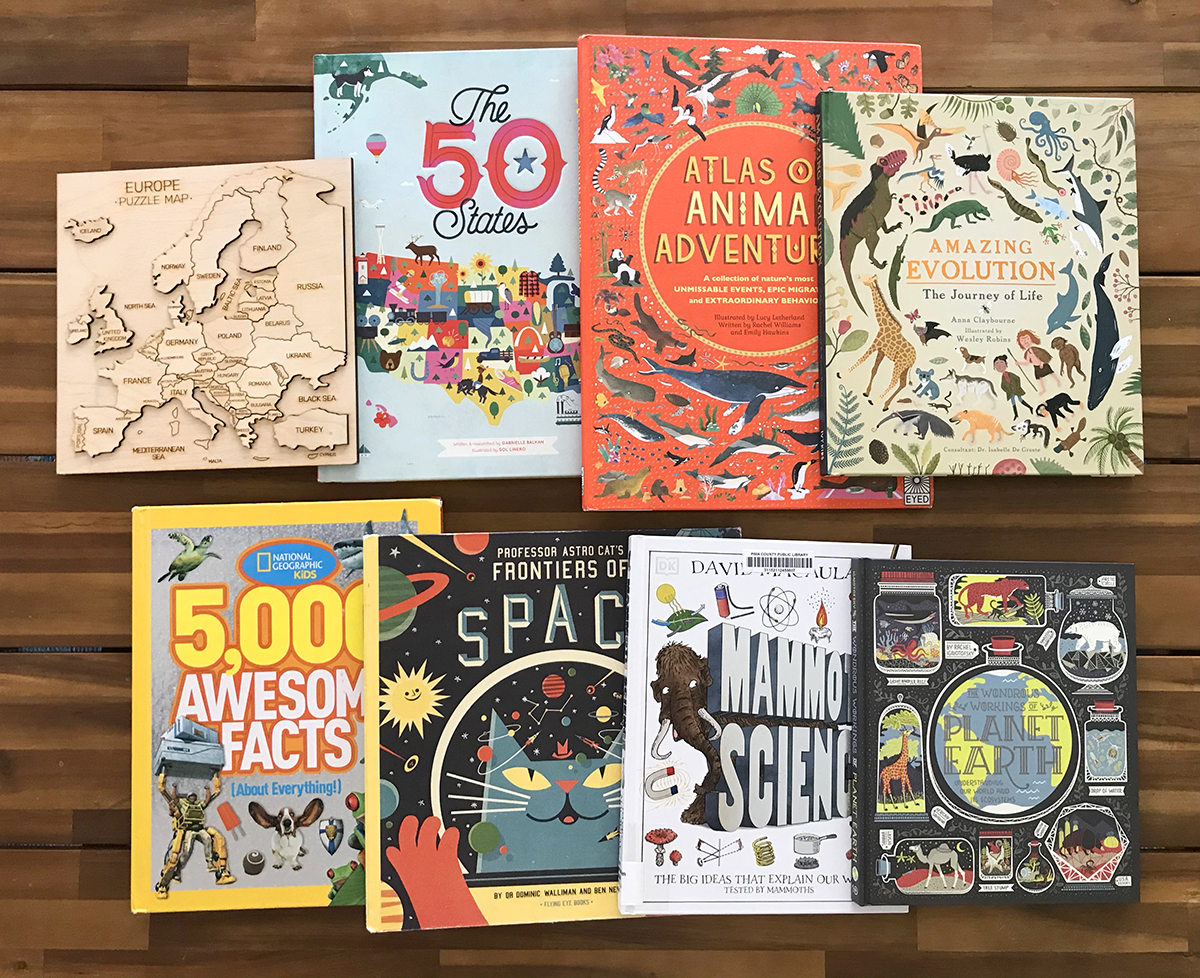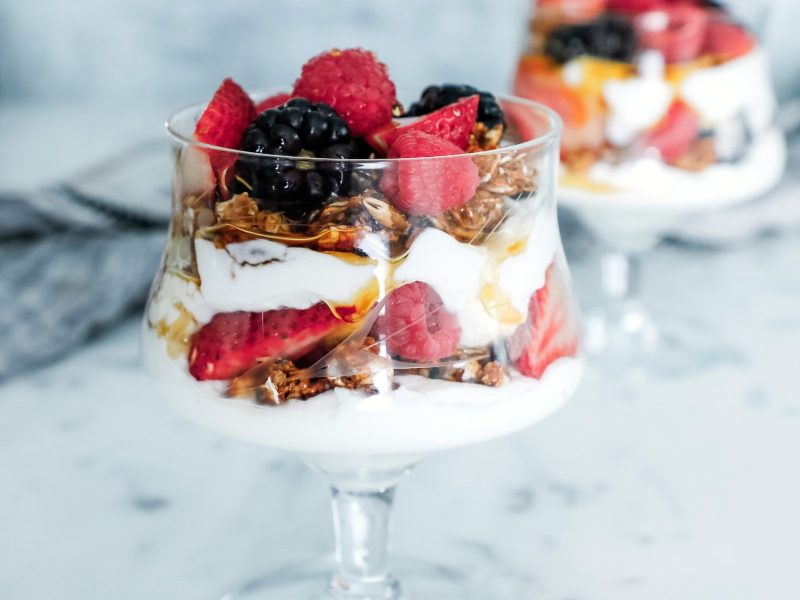I hope you find this book list (below) useful, either for summer reading or if you want to homeschool, then for homeschooling. I’ve homeschooled my kids for nearly 15 years, so this list comes from a LOT of research and experience. 🙂
School isn’t the bad guy. TV isn’t the bad guy. Computer games aren’t the bad guy. We watch TV. We play computer games. But what happens to SOME kids is that going to school and/or watching TV and playing computer games CAN be very overstimulating. Of course, kids don’t have the self-awareness to understand that they’re overstimulated. We parents are often unaware that they are overstimulated as well. So when we pull them out of school or tell them to turn off the screens and come here for homeschool time, then they fall apart, and cry or act out in frustration.
They don’t understand what’s happening to them. They are overstimulated.
You have to get them grounded before you can begin homeschooling, or before you can begin summer reading between grades. Getting them grounded doesn’t mean no activity. They can ride a bike or swim in the pool, or any form of exercise they like. Grounding them involves getting them out of that unnaturally overstimulated state of brain. When you cut out screens they may freak out at first, and scream and cry, but they will become grounded after stepping away from all things overstimulating, and *then they will be ready for gentle homeschooling.
To ground your kids you have to unplug them from all screens, at least until evening. They’re not going to like it at first, so BE PREPARED with things to do, as listed below. Before you unplug, below are some things I suggest having ready, most of which you probably already have. And you’re going to have to be an active participant with a lot of these! Don’t be on your phone or your laptop. Enjoy this quality time together! When they’re all grown up you will think of this quality time fondly. And once they’re grounded, they won’t need you nearly as much.
Ways to Unplug:
Cardboard boxes to make a fort or a tunnel
Tinker tray (follow the link and scroll down for more examples)
Coloring books
Word searches / crossword puzzles
Blank paper
Thin markers, thick markers, colored pencils, crayons, paint and brushes
Knitting materials
Chess
Checkers
Other board games (we love this one: Ocean Labyrinth)
Books from my book lists below
Books you know they like
Legos
Magnetic blocks
Lincoln logs
Beads and jewelry making supplies or just beads to sort (follow the link and scroll down for more examples)
Embroidery thread for friendship bracelets
Gardening supplies
Indoor bouncing ball (we have this one)
Mini Trampoline (we use this one)
Weighted Hoop
Bike
Scooter
Chalk for the sidewalk
Water table (follow the link and scroll down for more examples)
Bath toys
Baking supplies to bake together (cookies, treats)
Cooking ingredients to cook dinner together (stir fry, items to grill) (have them help you measure rice, add water and seasoning, fill the charcoal chimney, add the paper below)
Car wash (summer)
Snowman (winter)
Blow bubbles
Toy kitchen
Walk, go the the beach, go to the mountains
Go to the playground, the river, the lake
Go for a picnic (don’t forget to bring a ball for kicking or catching)
Squirt guns
Hide and seek
Dress up costumes (thrift stores are helpful)
Audiobooks
Recorder
Ukulele
Other instruments
Old magazines to cut and collage
Okay, so now your kids have become grounded. They’re sleeping a lot, and doing lots of things listed above. You’re ready for homeschooling. Here are some tips:
- Don’t ask your kids, “Do you want me to read you this?” or if they can read themselves, “Do you want to read this?” I’ve learned that when I did this, inevitably my kids turned up their nose, without even giving the book a chance. Instead, when it’s reading time JUST START READING. I can’t tell you how many books or series of books my kids fell in love with after initially turning up their nose. And I can’t tell you how many kids think they “hate” books, but they just haven’t found the right ones yet, or they were too overstimulated to read them. (See top of page for more on being overstimulated.)
- There is no reason why children should all be ready to learn their subjects at the same time. You may have a child who goes to school that you are told is “advanced” in reading or “behind” in math. This is absurd. A mom once said to me, “When you’re a grownup, nobody asks you at what age you stopped wearing diapers.” School is the same. Adults who meet each other don’t ask, “Did you know your multiplication tables by age 9?” Schools didn’t used to be arranged by age and grade. If you ever read Laura Ingalls Wilder books then you know that a classroom included children of all ages. Children were grouped together not by age, but by level. This is how it should be. The beauty of homeschooling is that at home there is no judgement, and you can accommodate them at the level they’re currently ready for.
- If they’re crying, then they’re 1) overstimulated, 2) not ready, or 3) they’re not getting the information in a format that makes sense to them. It’s one of those three things. It is NOT that they are “bad” or that their school teacher has failed them, or that YOU have failed. Breathe, rest, sleep, snuggle. Go back to the Ways to Unplug list above if you need to. Everything is going to be okay.
- Going with the big all-inclusive cirriculums like Math U See and Story of the World is great, but take your time with them, and make sure to supplement with plenty of smaller books for those subjects (listed below) to keep you and your kiddos entertained.
Notes:
Not that bigger kids won’t be fans, but books that my little kids especially like are noted in pink below.
I didn’t link to every single book for books that are part of a series, but I did link to at least one so you could find the series. 🙂
MATH
Lakeshore Multiplication Machine
My kids love this because it’s not only educational, but also a sensory tool, great for kinesthetic learners.
Murderous Maths Box Set, by Poskitt Kjartan
I put these on the list because there are many kids who love this “horrible” book series. If you have a kid that loves play-fighting, or thinks that “gross” things are hilarious, then these books are for them. Note: If they fall in love with this set then there are also Horrible Histories, Horrible Science, Horrible Geography sets.
Usborne
Usborne math workbooks are our favorites!
Math U See
Math U See is really popular among homeschoolers, and it’s my personal favorite math curriculum for when the kids are ready for each level. I don’t believe in rushing math, or any subject. Math U See videos make learning math as simple as possible.
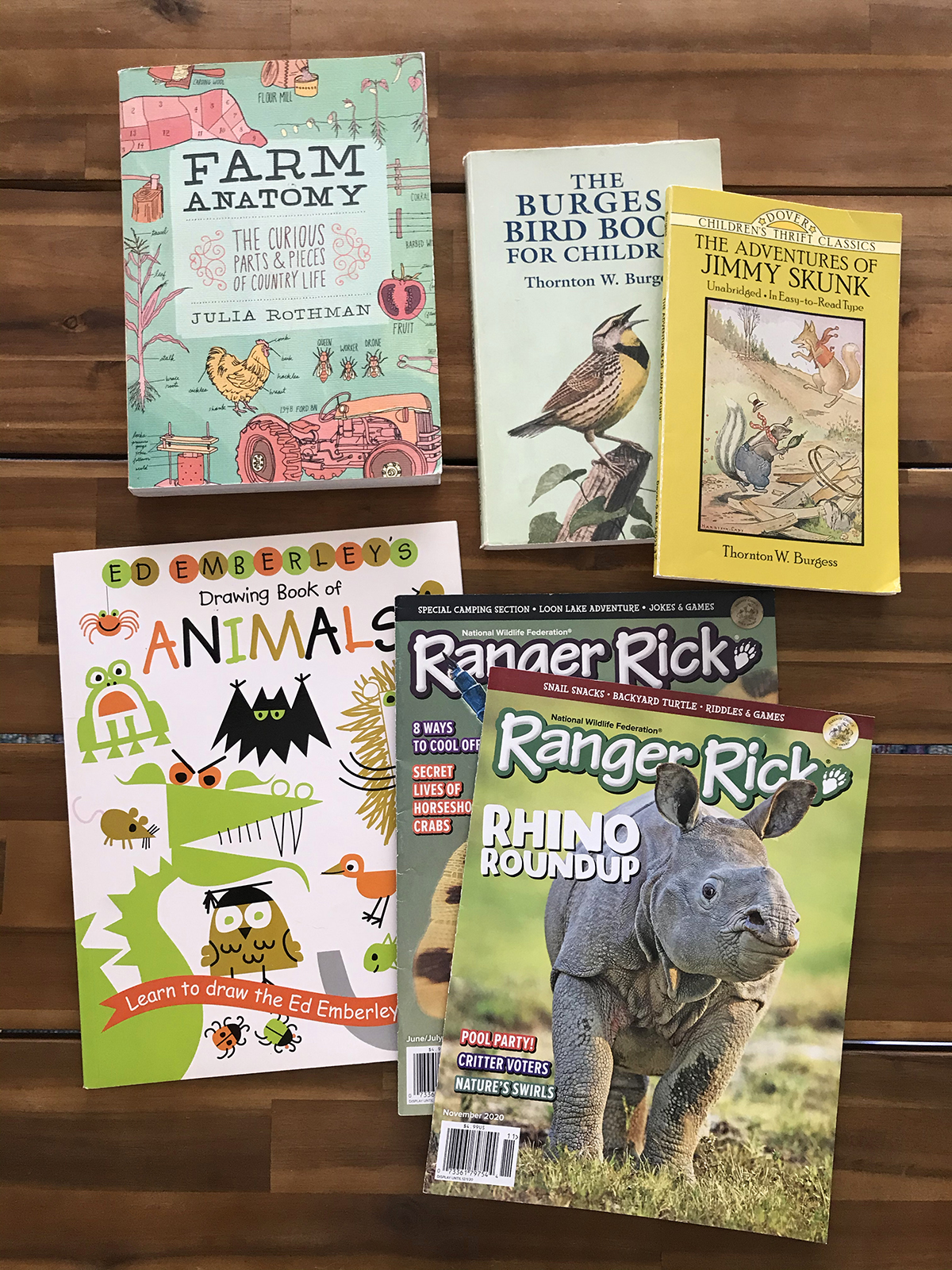
NATURE STUDY
Ed Emberley’s Drawing Book of Animals
This how-to-draw book is fun for kids and adults!
The Laws Guide to Nature Drawing and Journaling, by John Muir Laws
Take drawing even further with this simple yet awesome book.
Nature Anatomy Notebook: A Place to Track and Draw Your Daily Observations, by Julia Rothman
When you just can’t get enough of the previous two books, here is another one to love.
Burgess Books (The Burgess Bird Book, Blacky the Crow, Whitefoot the Wood Mouse, The Adventures of Buster Bear, Johnny Chuck, Grandfather Frog, Paddy the Beaver, Prickly Porky, Chatterer the Squirrel, Unc’ Billy Possum, etc)
Holling C Holling Books (Paddle to the Sea, Pagoo, Minn of the Mississippi, Sea Bird, Tree in the Trail)
The Anatomy books, by Julia Rothman:
Farm Anatomy: The Curious Parts and Pieces of Country Life
Ocean Anatomy: The Curious Parts & Pieces of the World under the Sea
Nature Anatomy: The Curious Parts and Pieces of the Natural World
Food Anatomy: The Curious Parts & Pieces of Our Edible World
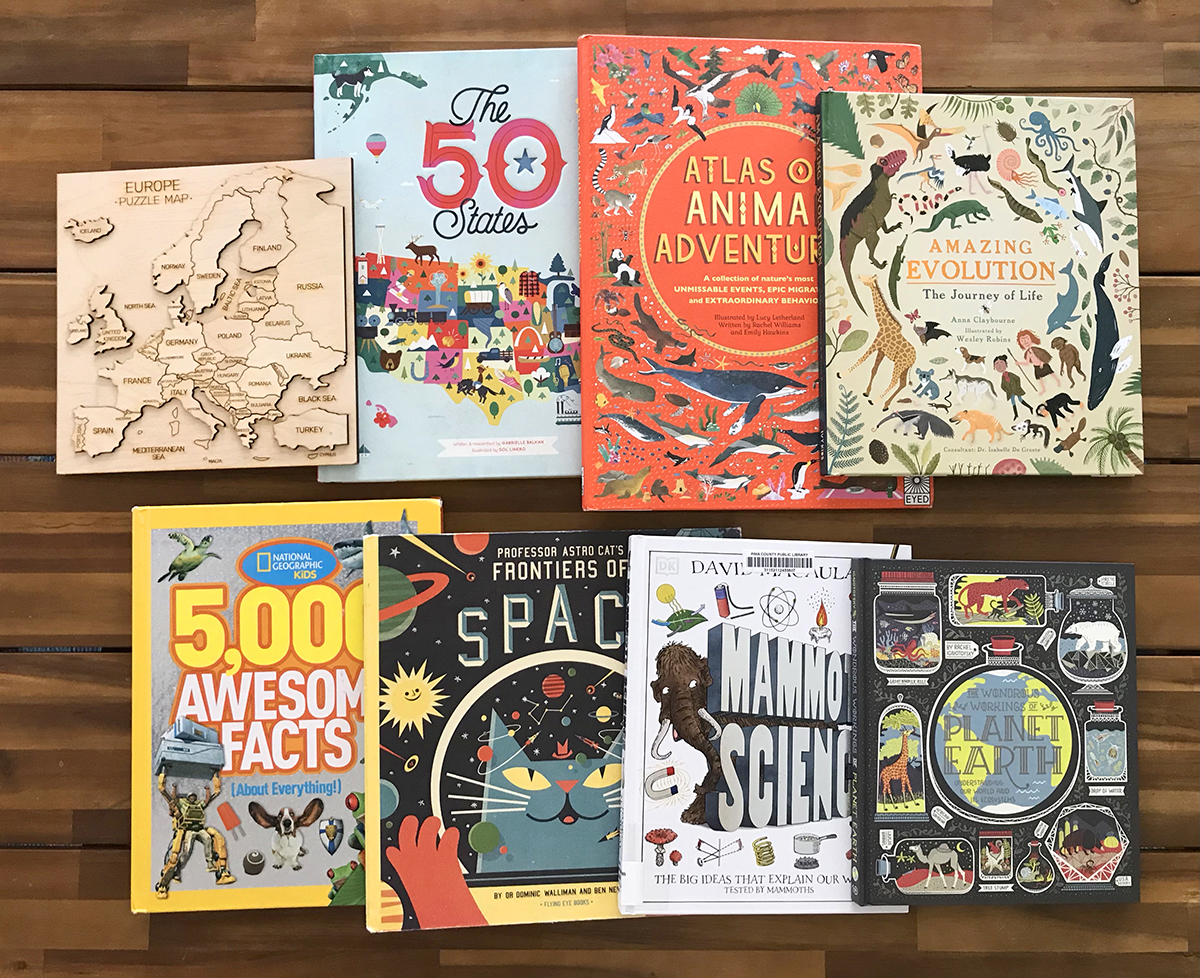
SCIENCE & GEOGRAPHY
Europe Puzzle
Obviously this isn’t a book, but it is very educational, and my kids love using it. Now they know where more countries are than I do!
The Wondrous Workings of Planet Earth, by Rachel Ignotofsky
Atlas of Animal Adventures, by Lucy Letherland
Fancy Nancy: Stellar Stargazer! by Jane O’Connor
Professor Astro Cat’s Solar System, by Dr. Dominic Walliman & Ben Newman (elementary)
Professor Astro Cat’s Frontiers of Space, by Dr. Dominic Walliman & Ben Newman (more advanced)
Mammoth Science, The Big Ideas That Explain Our World, by David Macaulay (beginner through advanced)
The Wondrous Workings of Planet Earth, by Ignotofsky (beginner through advanced)
Amazing Evolution, The Journey of Life, by Anna Claybourne (beginner through advanced)
The 50 States: Explore the U.S.A. with 50 fact-filled maps! by Gabrielle Balkan
The 50 States: Activity Book: Maps of the 50 States of the USA by Gabrielle Balkan
National Parks of the USA, by Kate Siber
Maps, by Aleksandra Mizielinska
Ultimate Weird but True Books, by National Geographic
Awesome Facts Books, by National Geographic
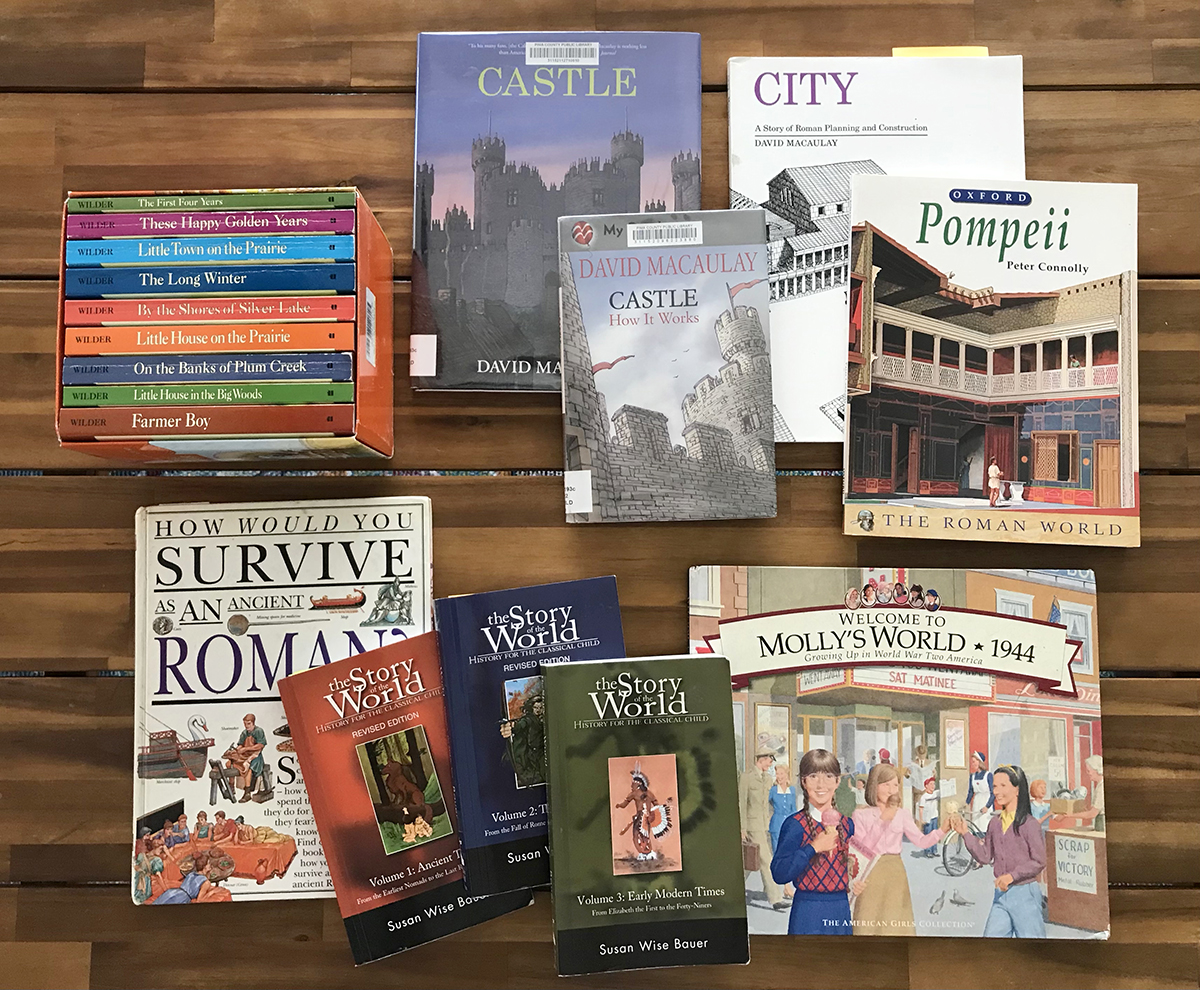
HISTORY
How Would You Survive Books (In the Middle Ages, As a Viking, As an Ancient Roman, In the American West)
These are some of the most engaging illustrated history books you will find.
Built to Last, by David Macaulay
Pyramid, by David Macaulay
City: A Story of Roman Planning and Construction, by David Macaulay
Castle, How it Works, by David Macaulay (elementary, story format)
Castle, by David Macaulay (beginner through advanced)
Below: SOTW (Story of the World) books are one of the most popular history sets of homeschoolers. They’re our personal favorite of this curriculum style.
Story of the World, Vol. 1 Bundle: History for the Classical Child: Ancient Times; Text, Activity Book, and Test & Answer Key, by Susan Wise Bauer
Story of the World, Vol. 2 Bundle: History for the Classical Child: The Middle Ages; Text, Activity Book, and Test & Answer Key, by Susan Wise Bauer
Story of the World, Vol. 3 Bundle: History for the Classical Child: Early Modern Times; Text, Activity Book, and Test & Answer Key, by Susan Wise Bauer
Story of the World, Vol. 4 Bundle: History for the Classical Child: The Modern Age; Text, Activity Book, and Test & Answer Key, by Susan Wise Bauer
The Little House Books (9 Volumes Set), by Laura Ingalls Wilder
I read these to my littles and they loved them so much that they later read them again to themselves.
The Children of Noisy Village, by Astrid Lindgren
Happy Times in Noisy Village, by Astrid Lindgren
These two books by Astrid Lindgren (the author of Pippi Longstocking) have been family favorites of ours since our oldest was very young. Your littles will want you to read them over and over. Such good memories of reading these to mine.
The Welcome To books:
Welcome to Kaya’s World 1764: Growing Up in a Native American Homeland
Welcome to Felicity’s World, 1774: Growing Up in Colonial America
Welcome to Josefina’s World 1824: Growing Up on America’s Southwest Frontier, by Yvette Lapierre
Welcome to Kirsten’s World, 1854: Growing Up in Pioneer America, by Susan Sinnott
Welcome to Addy’s World, 1864: Growing Up During America’s Civil War, by Susan Sinnott
Welcome to Samantha’s World-1904: Growing Up in America’s New Century, by Catherine Gourley
Welcome to Kit’s World, 1934 : Growing Up During America’s Great Depression, by Harriet Brown
Welcome to Molly’s World, 1944: Growing Up in World War Two America, by Catherine Gourley
We adore these scrapbook-like books, and find them the most engaging. They’re like visiting a museum, perfect for the visual learner.
Rick Steve’s Europe, ricksteves.com
these are videos, not books, but I had to include them because they’re so great
FAVORITE BOOKS FOR PARENTS
Teach a Child to Read with Children’s Books, by Mark B. Thogmartin, Ph.D.
A Charlotte Mason Education: A Home Schooling How-To Manual, by Catherine Levison
The Call to Brilliance: A True Story to Inspire Parents and Educators, by Resa Steindel Brown
Rethinking School: How to Take Charge of Your Child’s Education, Susan Wise Bauer
xoxo
♥, Kelly
